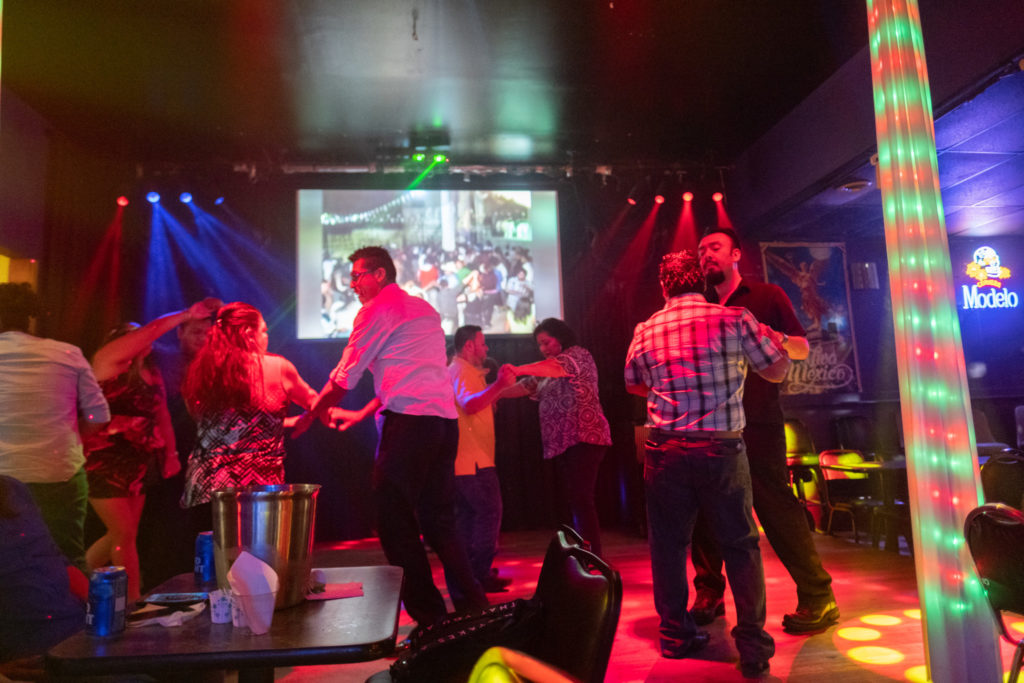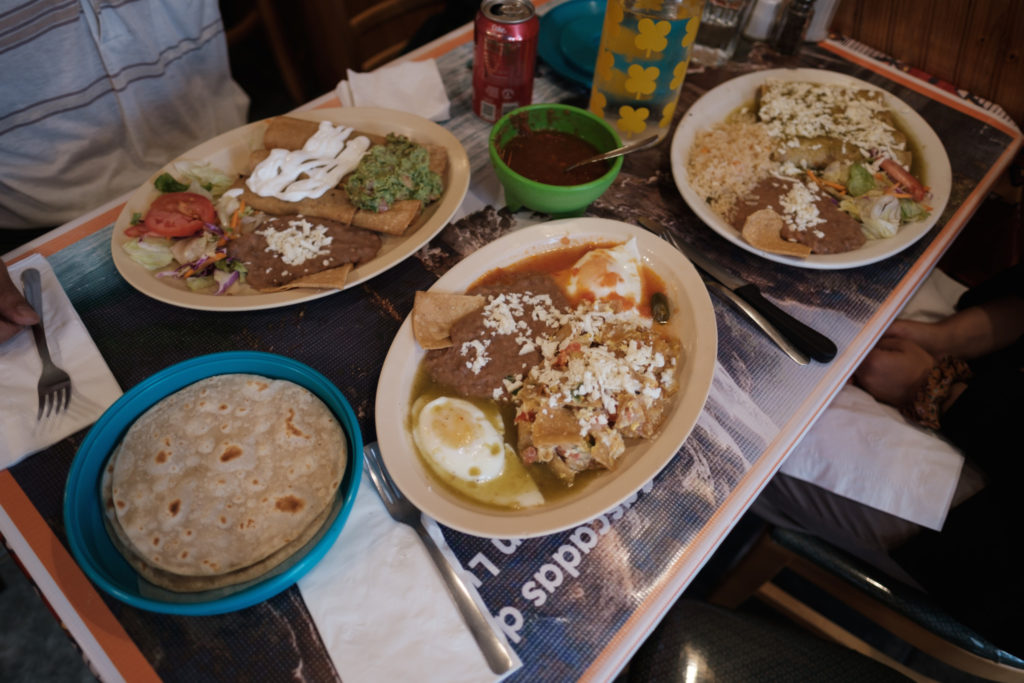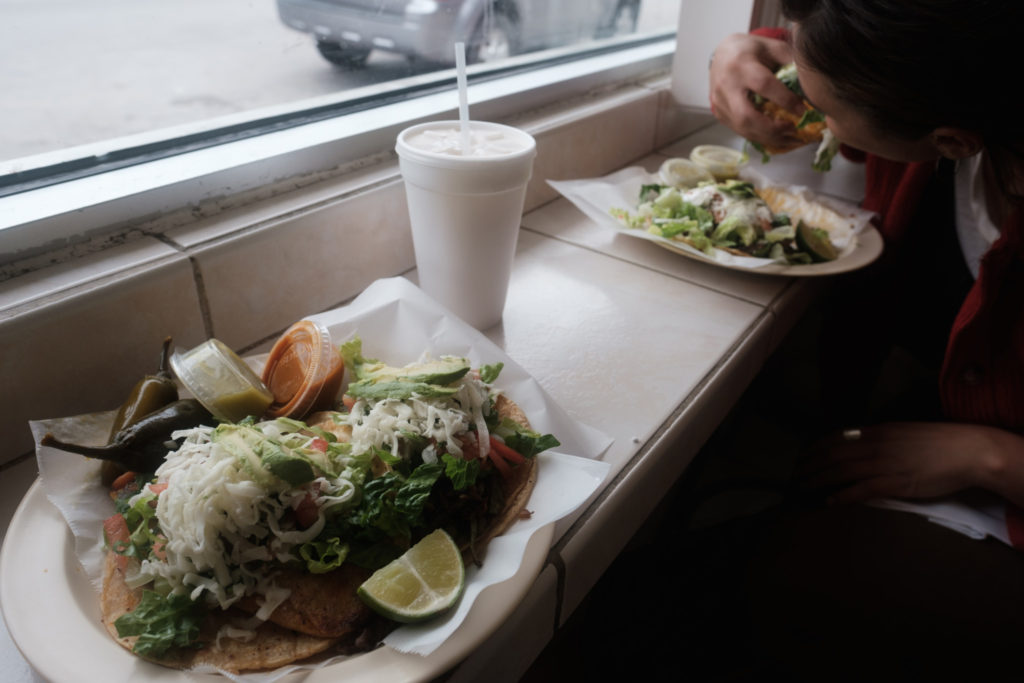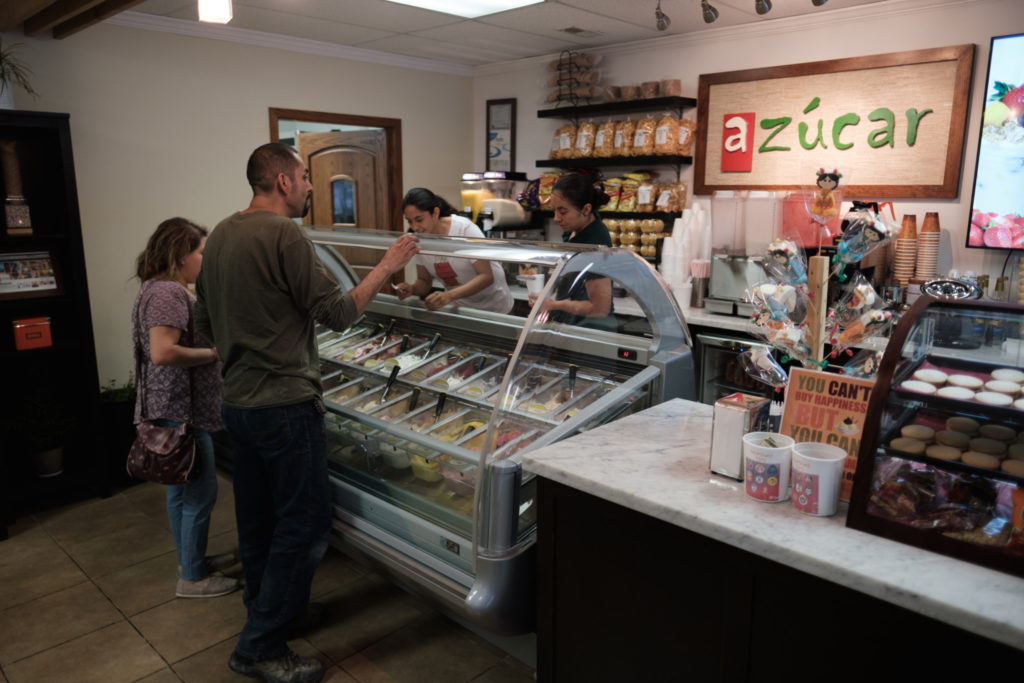- Best Community Networkers: Little Village Solidarity Network and Blood Fruit Library
- Best Drag and Trans Institution: La Cueva
- Best Huevos Divorciados with a Side of Homemade Tortillas: Los Candiles
- Best Prayers over Mexican Breakfast: La Catedral Café and Restaurant
- Best Tacos the Size of Your Face: Los Olivos
- Best Selection of Homemade Nieves: Azúcar
The Little Village neighborhood was the primary destination for the wave of immigrants that arrived in Chicago from Mexico in the 1980s. Since the gradual loss of Pilsen—a former port of entry—to gentrification, Little Village has become the stronghold of the city’s Mexican community. The area is characterized by a culture of walking, encouraged by two miles of local commerce, accessible public transportation, summer block parties and open hydrants, street vendors year-round, murals, and a tradition of talking to your neighbors. As new generations of Little Village residents attempt to build economic and political power, they face the challenge of determining how to improve their community in a way that does not invite invasive outside interests that threaten their way of life.
Jackie Serrato is an independent journalist and lifelong Little Village resident. She started the “La Villita, Chicago” group on Facebook, which now has more than 140,000 members.
Best Community Networkers
Little Village Solidarity Network and Blood Fruit Library
When I first asked Pura, an organizer with Red de Solidaridad de La Villita, or the Little Village Solidarity Network (LVSN)—a group organizing against gentrification, evictions, foreclosures, stolen wages, deportation, and migrant child detention—about their work in Little Village, she wanted to clarify: “Little Village is what outsiders call what people inside the neighborhood call La Villita. That’s really important, because it also sets a line on who’s looking in and who’s looking out. So the perspective is very important. Some of the people that we organize with are not from La Villita, but total allies, and some of the people who currently live in La Villita are newer transplants. We need to understand the difference between a gentrifier and a person that comes into the community and wants to live within the community. So it’s not about isolating anyone or about a class system—it’s about who really has the interest of the community at hand.”
LVSN came out of a struggle to prevent the privatization of a public placita at the corner of Marshall Boulevard and Cermak Road. With support from 12th Ward Alderman George Cardenas, Sip22, a white-owned coffee shop, sought to claim the public space for a private patio. (Sip22 recently closed and is now under local ownership under the name La Frida.) In preparation for a patio conversion, the public benches from the corner were removed. Their fight began with the construction of new benches that still stand sturdy in their sherbert glory, hand-painted with nature murals and messages like “de barrio, para el barrio” (by the neighborhood, for the neighborhood). As part of their efforts to reclaim the space, they had a free store and offered free food and arts and martial arts classes.
While that corner has been successfully saved for now, there are new concerns about a larger beautification project along Marshall Boulevard, organized by the OPEN Center for the Arts with support from the Lincoln Park Zoo, that may aid in the gentrification of Little Village.
While LVSN traces its genesis to the struggle on Marshall and Cermak, it is also influenced by its members’ previous decades of organizing with groups like Moratorium on Deportations, Semillas Autónomas, and the disability rights activist group ADAPT—all of whom use many of the confrontational tactics of occupation and community-building now seen in LVSN—and is modeled in part after the Seattle Solidarity Network.
LVSN describes itself as a non-hierarchical organization that “organize[s] first and foremost horizontally.” Much of their work is in supporting workers who need help recovering stolen deposits or unpaid wages and tenants who face the immediate threats of foreclosure and eviction. As far as their tactics, they begin by gathering a group of at least fifteen from across their network (from organizations like the Greater Chicago I.W.W., Tenants United, Haymaker Gym, and the Chicago punk community) and reading a letter of demands to the offending boss or landlord. If the offender refuses to act, they escalate to pickets and boycotts until the issue is resolved. They will fight in solidarity for anyone who comes to them in need. “Community is not just the people that live in your neighborhood. If someone in Hyde Park needs assistance, if someone from the North Side needs assistance, we have been available,” said Pura. They also recently published their principles of affiliation in the most recent issue of the zine Sick Muse, describing “the ways we are committing to struggling alongside other groups.”
Most recently, they’ve been organizing against the nonprofit child migrant detention centers recently exposed by ProPublica Illinois. Here in Chicago, the detention centers hold over four hundred migrant youth in Bronzeville, Rogers Park, Englewood, Beverly, and suburban Des Plaines. These centers are run by the Heartland Alliance and the Catholic Archdiocese (some of the latter are run through the social service agency Maryville). The organizers have found that many people don’t even realize that they’ve lived next to detention centers for years. Some Rogers Park residents were so horrified that they started a similar organization, the Rogers Park Solidarity Network. Additionally, Chicago DSA and other local organizations have supported this work as part of a #FreeHeartlandKids campaign. So far, public pressure from organizations like the LVSN have gotten Heartland Alliance to close down four of their centers, though Heartland Alliance claims that the closures were a result of their leases ending. LVSN and its allies have also called for boycotts of those who collaborate with ICE and DHS. A recent action disrupted business at an Amazon distribution center in Little Village, as Amazon Web Services hosts almost all of ICE and DHS’s data.
Over its nearly two-year existence, LVSN’s home base has been the Blood Fruit Library, a radical library and event space. This partnership reflects LVSN’s core mission: empowering community members through shared knowledge and space. “We’re always trying to assist in helping people find their knowledge and their strength and telling them…we’re going to stand alongside you,” says Pura. “We are first and foremost educating people and showing them that you too can assemble, you too can show your power and demonstrate.” Beyond organizing their own efforts, LVSN has been offering children’s programming at Blood Fruit, as well as planning work with communities across borders—“borders that are not put in place by the people,” Pura clarifies.
Blood Fruit, whose library was seeded in part by the now-defunct Biblioteca Popular, has plans to become a “fully operational community space for Chicago’s West Side neighborhoods.” Their dream, as expressed in a recent update, “is to establish a land trust to help prevent gentrification in these neighborhoods, and build a radical social history archive in addition to expanding our printing and publishing operations.”
At the heart of their intersectional organizing is indigenous sovereignty and autonomy. In their words, they’re “trying to build ties with people that are organizing with their hometown, or their ancestral lands, and that support indigenous sovereignty. We really need to understand that in order to fix any mistake, we need to start with respecting and assisting in indigenous sovereignty, because that is how we can come full circle. […] Are you an ally? Because that’s the bottom line—Are you with us? Because if you’re not with us, then, sadly, you’re against us.”
Red de Solidaridad de La Villita or the Little Village Solidarity Network, Blood Fruit Library. (475) 330–8481. Lavillitasolidaridad@gmail.com. facebook.com/lavillitasolidaridad
Blood Fruit Library. To collectivize your books or reserve Blood Fruit for an event: bloodfruit_library@riseup.net. facebook.com/BloodFruitLib
Best Drag and Trans Institution
La Cueva

La Cueva, often called the oldest Latino drag bar in the country, has been a haven for trans women performers and vaqueros for decades. It opened in 1972 and started having drag performances in the early ’80s, as covered in a 2006 Reader feature on Ketty Teanga, La Cueva’s original mistress of ceremonies (that honor now belongs to Vanessa Dorantes). Once nondescript from the outside, with only a lonely lit beer sign signalling its entrance, it now proudly features a stylized rainbow LA CUEVA sign across its exterior windows. Inside, every Friday, Saturday, and Sunday night you’ll find glowing renditions of Mexican and Puerto Rican staples alongside spunky Selena routines (and the rare Gaga performance).
Even in a post-Drag Race world, where lipsyncs, death drops, and contouring tutorials are a part of mainstream culture, it’s often difficult to feel welcome at North Side drag staples like Roscoe’s if you aren’t a white gay cis man. There’s something special about the space that La Cueva holds: it’s rare to find such an inclusive and fluid mix of gender and sexuality—in between sets, as some performers serve tables and mingle with guests, older couples dance to cumbia alongside friends and lovers, queer, straight, and in-between, on the moodily lit stage-turned-dance-floor.
Despite efforts in 2011 to shut down the club, in part led by then-aldermanic candidate Raul Montes Jr., La Cueva survives. You can still find Gabrielito resplendently impersonating Mexican icon Juan Gabriel (in front of video of Juan Gabriel live performances so you can see just how much Gabrielito has mastered his regal half smiles and elegant strides), decades after his debut on La Cueva’s stage in the early ’90s.
For especially spirited performances or favored performers (the drag kings in particular draw some adoring embraces), patrons leave behind their buckets of Modelo and fire-truck-red seasoned michelada rims to tuck dollar bills in sequined gowns and lacy leotards in exchange for a few swaying clutches or a pair of kisses. (J. Michael Eugenio)
La Cueva Night Club, 4153 W. 26th St. Thursday, Friday, and Sunday 8pm–4am; Saturday 8pm–5am. Thursday: Open Mic Karaoke; Friday and Sunday shows at 11:45pm and 2:15pm; Saturday show 1:15am–3:15am. (773) 475-6544. bit.ly/LaCuevaChi
Best Huevos Divorciados with a Side of Homemade Tortillas:
Los Candiles

Despite Chicago’s abundance of taquerias and Mexican restaurants, it’s still relatively rare to find fresh handmade flour tortillas. It’s also rare for a restaurant to have nearly a hundred black and white portraits from the golden age of Mexican cinema adorn its walls. More, each table at Los Candiles is draped with custom tablecloth collages, each highlighting a different actor or actress.
Run by the sibling pair of María Lola, the manager, and José Luis López, head chef, Los Candiles marries cuisines from San Luis Potosí and Nuevo León. It serves some of the best Mexican breakfast in the city, with fantastic treats like atole de teja (a traditional sunflower seed drink from San Luis Potosí) and enchiladas huastecas or potosinas (the latter made with plenty of guajillo chiles)—but they are especially renowned for their huevos divorciados, the food equivalent of the Mexican flag: fried eggs covered in salsa verde and salsa rojo are separated by a bed of chilaquiles topped with cheese (fresh or melted, your choice!).
Los Candiles, 2624 S. Central Park Ave. Monday–Friday, 7am–3pm; Saturday–Sunday, 7am–5pm. (773) 522-8544.
Best Prayers Over Mexican Breakfast
La Catedral Café and Restaurant
For this experience I need to thank People’s Gas—not something you hear people saying every day. Tearing up my street and towing anyone still parked after 7am was annoying at first, but it forced me to get up earlier than usual and get out of the house. On the recommendation of a friend, I decided to check out La Catedral, which was only a few blocks away and opened at 7am.
The building itself looks like a tiny cathedral from the outside, with large stones and a tower on the corner of the building. I was one of the first customers that day and sat next to the windows, early morning light streaming in and adding an orange glow to the beautiful interior, complementing the bright yellow of the walls.
Whoever decorated La Catedral kept the name firmly in mind as they put up dozens of crosses on the lower level, and the several statues of the Virgin Mary. According to their website, many of these decorations were given to them by guests. The ceiling is painted as if it were the inside of a Catholic cathedral, with familiar (to those of Catholic heritage) images of angel cherubs and heavenly clouds. There is an entire second floor, presumably reserved for the holiest of customers allowed to be that much closer to God.
I ordered cafe de olla and the regular chilaquiles. The cafe de olla was just the right combination of sweetness, spice, and dark coffee. The eggs came out nicely runny and the red sauce was spicy and savory, smothering the tortilla chips with flavor. It being a “café,” I felt comfortable working on my laptop for a bit before heading out. By the time I left two hours later, the cafe was filling up with customers that seemed like they knew the place or had likewise heard about it from a trusted friend. The staff was friendly and made me feel at home. (Adam Przybyl)
La Catedral Café and Restaurant, 2500 S. Christiana Ave. 7am–3pm, every day. $1.75–$14.99. (773) 823-7546. chefambrociogonzalez.com
Best Tacos the Size of Your Face
Los Olivos

Over its thirty-three years, Los Olivos and its abundant breakfasts and lunches have cultivated a devoted following. Enter its minimal white facade on a lonely strip of 31st Street, a few blocks from the Cook County Jail, and you’re bound to find someone reminiscing about the first time they came a decade ago, sharing laughs with the staff, and extolling the superiority of their tacos. (I’m not exaggerating—this has happened both times I’ve been!) Many regulars swear by their menudo, served only on weekends (their barbacoa is also a weekend special). Everyone agrees that nowhere else in Chicago can you get such large portions of authentic Mexican fast food classics served so fresh. It’s a little disarming to find ingredients so flavorful outside of a San Antonio food truck or a Merced gas station. Each taco is piled high with (non-iceberg!) lettuce, avocado, tomato, sour cream, and cheese, plated with pickled jalapenos and carrots, and served with housemade red and green salsas.
Mama Zaleta Olivo presides as head chef of the restaurant, which she opened with her husband Cecilio in 1986. Their menu proudly proclaims their mission, “EVERYTHING MADE FRESH AND PREPARED AS IF YOU WERE FEEDING YOUR OWN CHILDREN.” Seeing as it’s staffed by their sons and daughters, along with a couple extended family members, it truly is a family restaurant through and through, from their origins in Zacatecas to their new home in Chicago.
No matter which items of their “Mexican soul food” (as one of the Olivo’s sons calls it) you get—their brimming burritos, tortas, tacos, gorditas, sopes, quesadillas, or breakfast moles—you’ll come away full of food and joy. (J. Michael Eugenio)
Los Olivos, 3400 W. 31st St. Monday–Friday, 6am–4pm; Saturday–Sunday, 6:30am–4pm. (773) 247-1002. losolivoschicago.com
Best Selection of Homemade Nieves
Azúcar

Walking into Azúcar, you might think you’ve stepped into the waiting room of a dental office: their clean and orderly eating area has shiny black leather loungers, a potted dragon tree, and a television tucked in the corner. After trying their wonderful vibrant nieves, you might soon find yourself needing a dentist! The flavors are inspired by Angel Garcia’s home of Cuernavaca, the largest city in the Mexican state of Morelos. Some of the frozen standouts include the creamy and balanced platano con nutella, the fluorescent Mexican mango con chile, and the elote, which tastes a bit like the most artisanal corn pops you’ve ever had. That said, every flavor that we tried was distinct, fresh, and perfectly sweetened—and it’s priced low enough for you to visit every day of the summer. Shockingly, you can get two scoops of these fresh handmade treats for just $2.50! (J. Michael Eugenio)
Azucar, 3617 W. 27th St. 9am–9pm daily. (773) 486-6464. facebook.com/AzucarChicago

